How to Summarize YouTube Videos with AI in 2024

Do you want to extract valuable information from a YouTube video – without watching it all?
Summarizing a YouTube video using AI is the way to go.
Through this process, you can also refer back to the main ideas without going through the video again. This ability often comes in handy in a world where applied knowledge is power.
The best part? You can have a summary ready to go within a few seconds.
In this post, I’ll share with you:
- how to summarize YouTube videos using AI
- the best tools to make this happen
- key factors to look for in a YouTube video AI summarizer tool
- the best ideas to help you make the most out of your summaries.
- How to Summarize YouTube Videos Using AI
- Best 4 Tools to Summarize YouTube Videos Using AI
- 1. ChatGPT
- 2. Claude AI
- 3. Jasper
- 4. Otter.ai
- What Makes a Good AI YouTube Video Summarizer?
- The Tool Considers Context
- Ability To Add Prompts
- Removes Unnecessary Information
- Fast Processing Time
- Unlimited Generations
- What To Do After You Summarize A Video
- Review and Edit the Summary
- Consider Content Utilization
- Think Of Collaborative Opportunities
- Conclusion
How to Summarize YouTube Videos Using AI
Here’s how to summarize YouTube videos using AI in a step-by-step format:
- Step 1: Copy the YouTube video transcript (more information next)
- Step 2: Go to your AI summarization tool (I provide my favorites below)
- Step 3: Paste in your transcript
- Step 4: Click Summarize
- Step 5: Wait for the transcript to generate
Here are the steps to step 1 (a.k.a. copying the YouTube transcript):
- Go to the YouTube video description and choose Show Transcript:
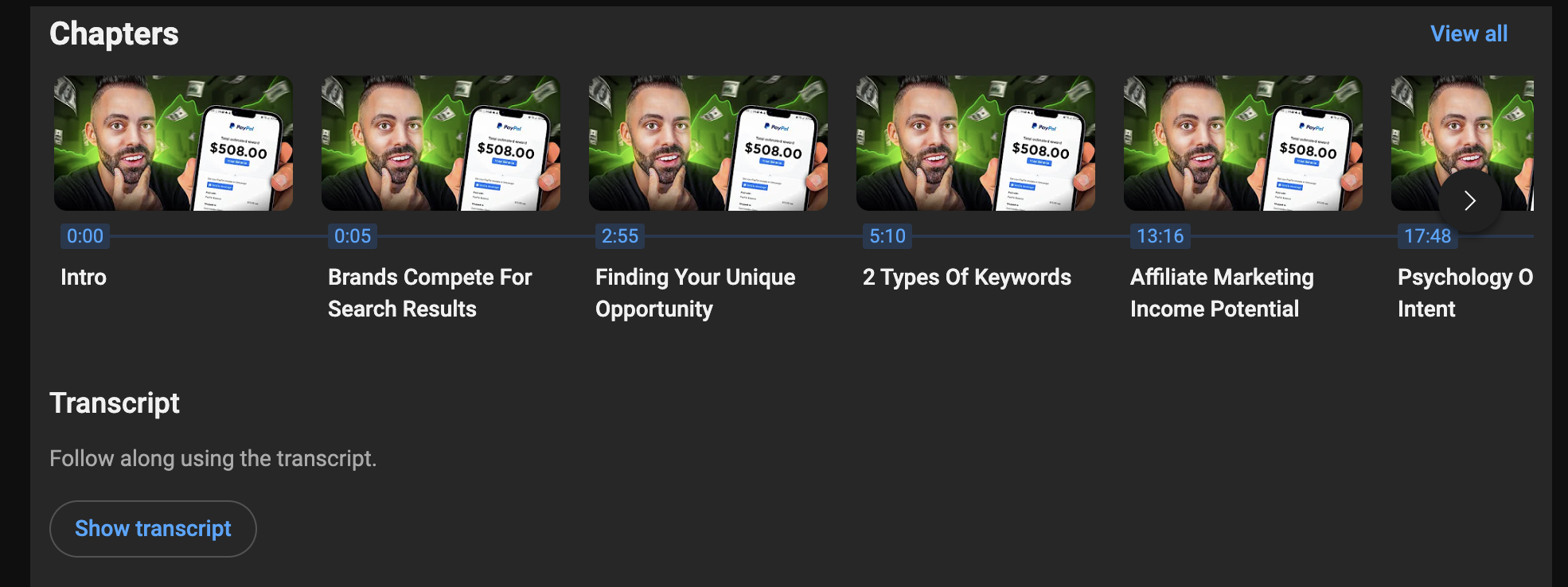
- The transcript loads up on the right-hand side of your screen:
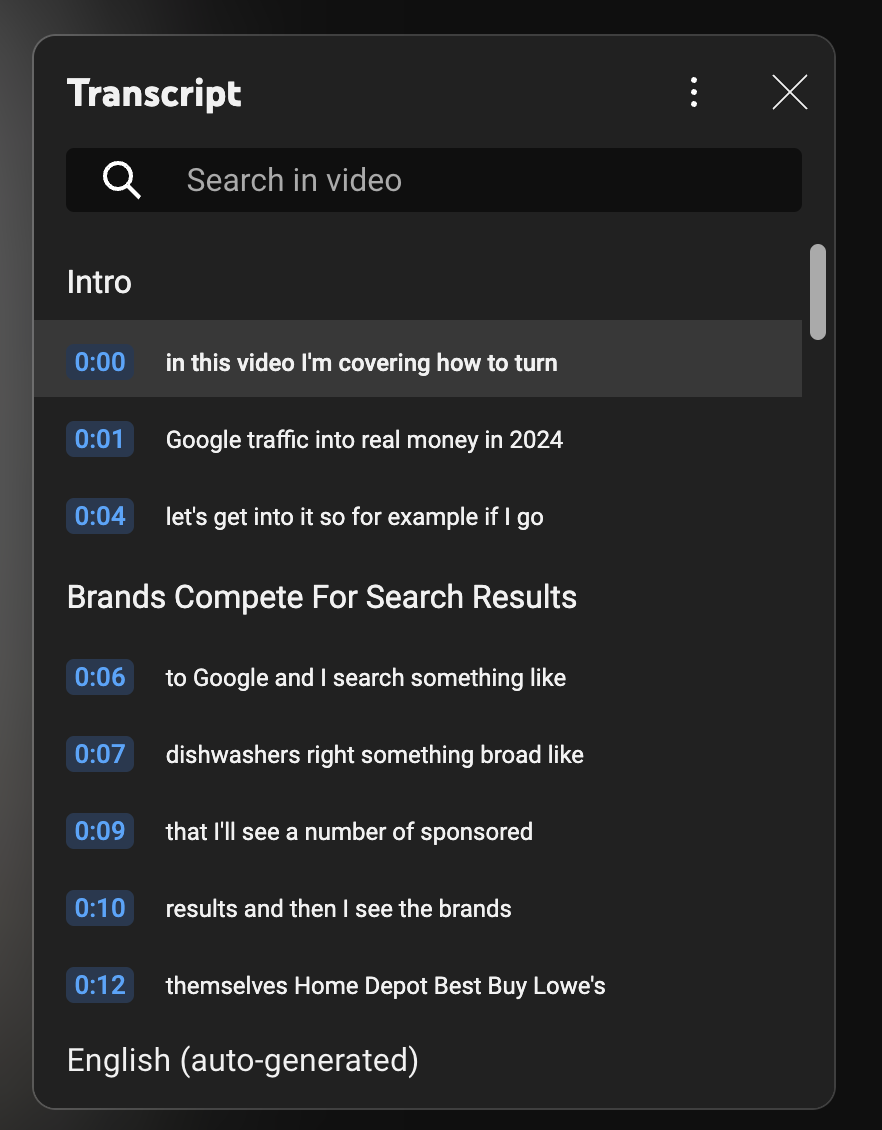
- You can hit the three dots and choose Toggle timestamps
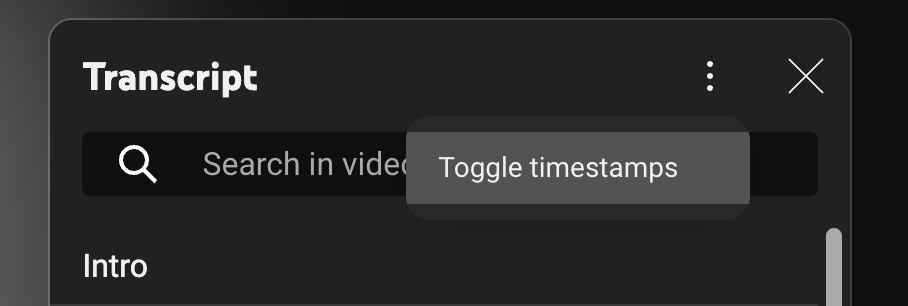
- Drag and drop your mouse to highlight parts (or all) of the transcript:
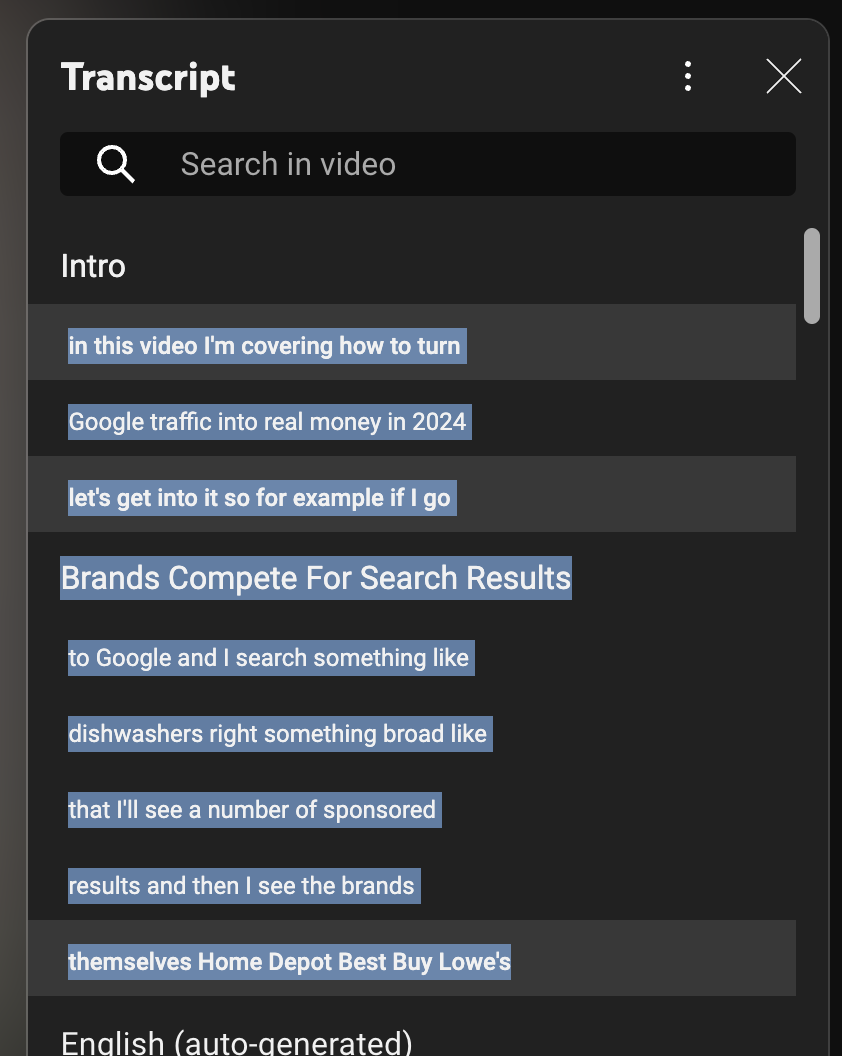
- Press CTRL (Windows) / CMD (Mac) + C on your keyboard to copy the transcript into your clipboard.
Side Note: If you can’t get a transcript, the video creator might have disabled this option. Here are different ways to get YouTube transcripts in this case.
In some cases, you can avoid all the above and directly insert the YouTube URL into the AI tool, as follows:
- Step 1: Go to your AI summarization tool
- Step 2: Insert the video URL into the tool
- Step 3: Click Summarize
- Step 4: Wait for the transcript to generate within the tool you choose
Either way, you’ll have a YouTube video summary ready to go. Something similar to the below (depending on the tool you choose):

So which tools can you use to create these summaries? Glad you asked!
Here are my top choices.
Best 4 Tools to Summarize YouTube Videos Using AI
Here are the best tools to summarize YouTube videos using AI.
1. ChatGPT
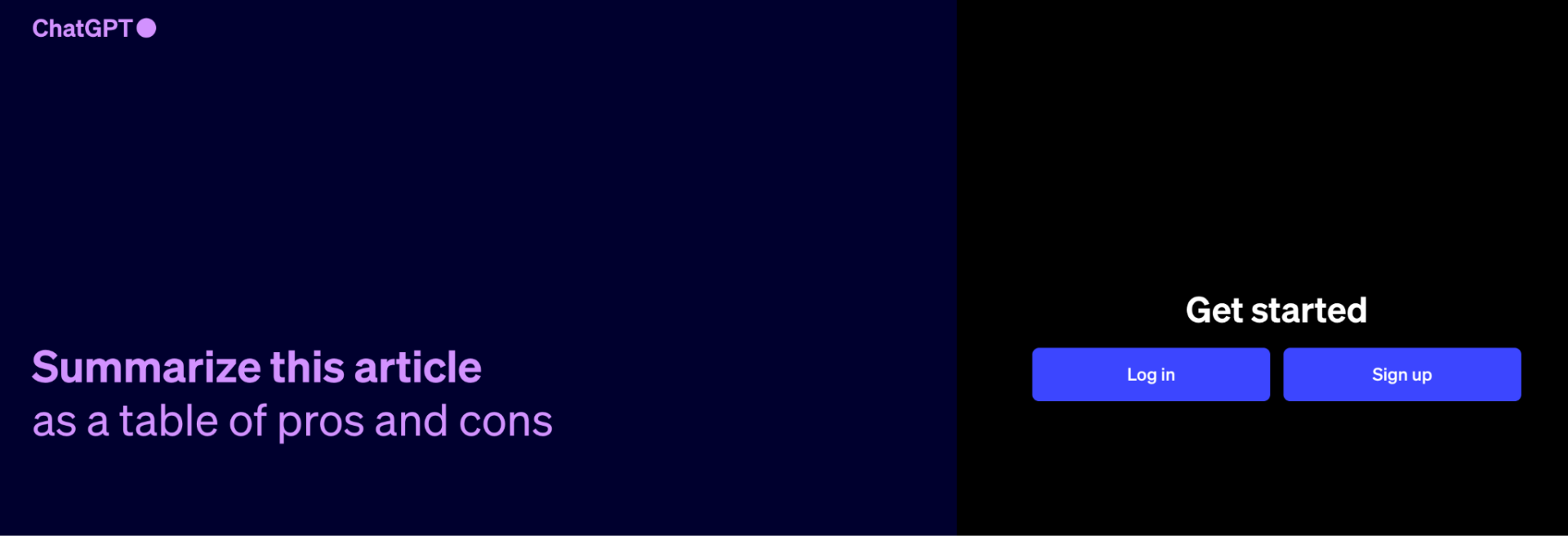
ChatGPT needs no introduction. OpenAI made this language learning model public a couple of years ago. Using ChatGPT, you can create video summaries (and much more).
You can also expand on the given summaries to create additional content based on your needs (more on this in the What To Do After You Summarize A Video section below).
ChatGPT accepts prompts as inputs and then creates outputs. The great thing is that you can always customize the type of prompts you give if you aren’t getting the desired output – or just simply want more control.
ChatGPT Pros:
- Fast processing: You can quickly generate outputs – there’s no need to wait long to get your video summaries.
- Large input ability: ChatGPT can handle entire video transcripts in one go. You don’t have to break down videos into smaller iterations for them to fit in the allowed input limit.
- Detailed outputs: From one video, I got as many as 12 summary points, all with their subpoints. This structured summary makes it easy to go through and remember the main points.

ChatGPT Cons:
- Further tweaking is sometimes needed: As the user, you don’t get specific YouTube summary templates, so your prompts must be on point (or adapted over time) to get the best results.
2. Claude AI
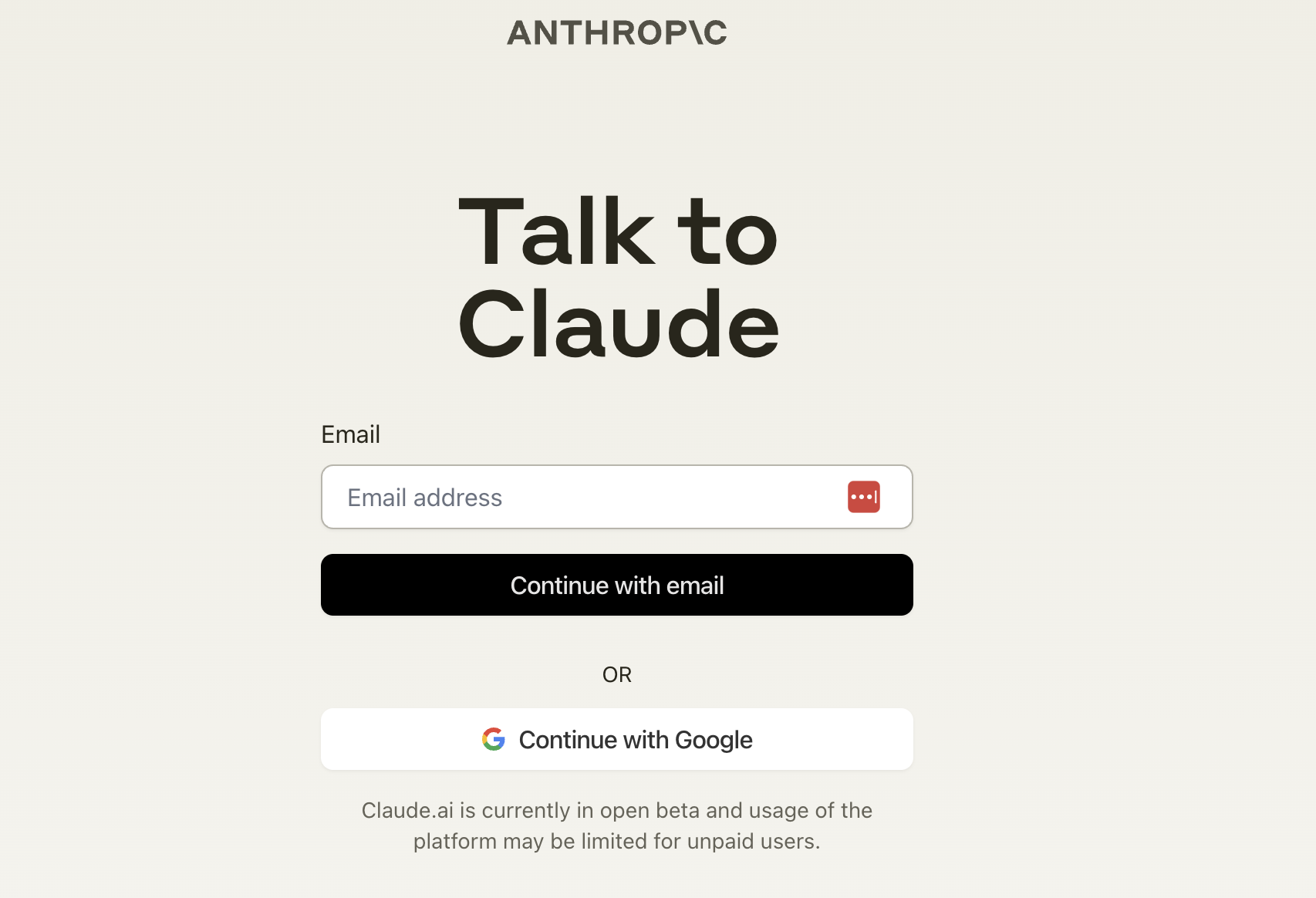
Claude AI is a tool that makes light work of creating video summaries. As of the time of writing, it’s in beta mode. This means that things should only get better (and they’re already at a high standard).
Users can paste text directly into the chat and get grouped information. This formatting makes it much better to see (visually speaking) compared to ChatGPT.
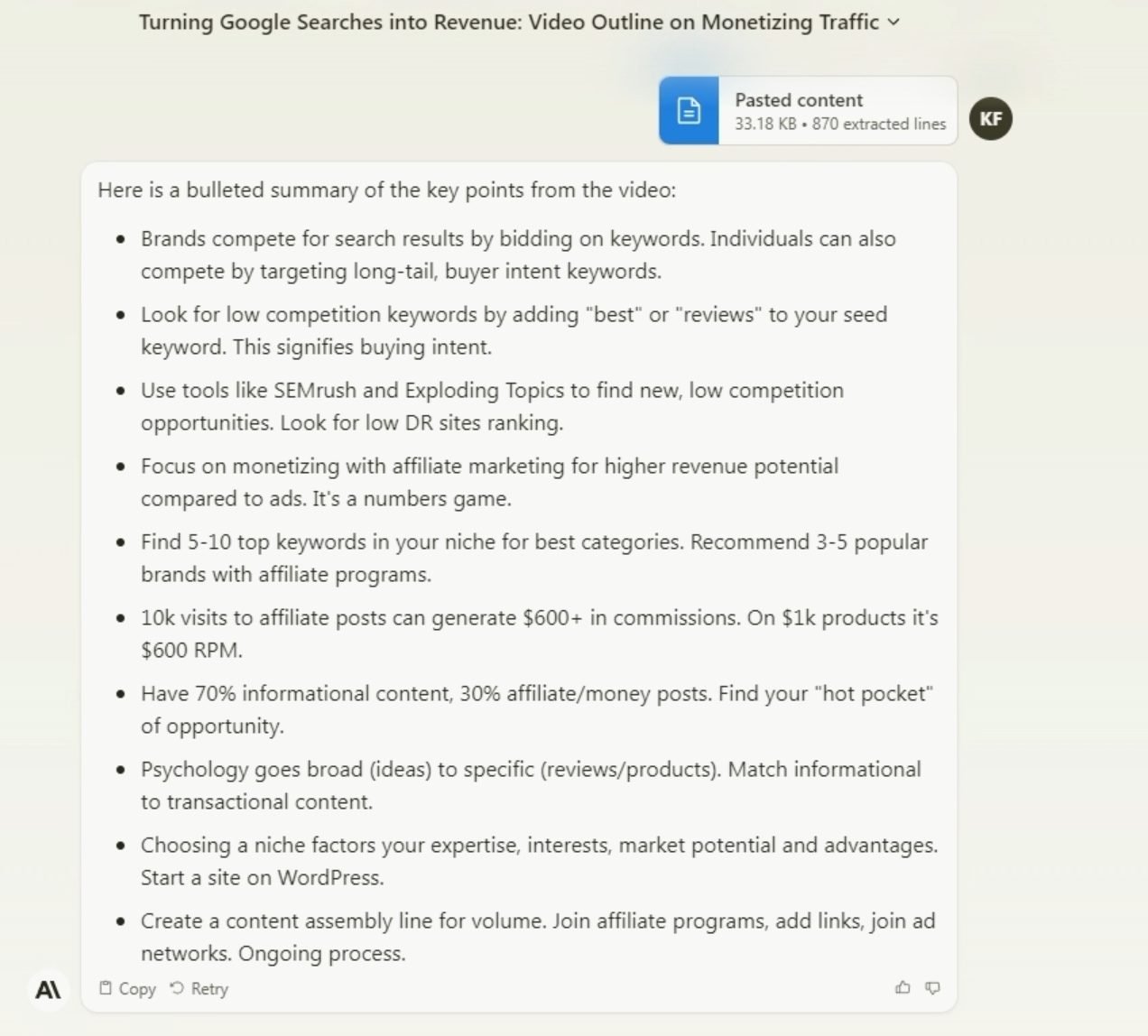
In our use case, the summary is in bullet form and pretty much in action-steps format already. The result? You have one less step to take if you want this type of summary (compared to a tool like ChatGPT, where you have to ask for action steps).
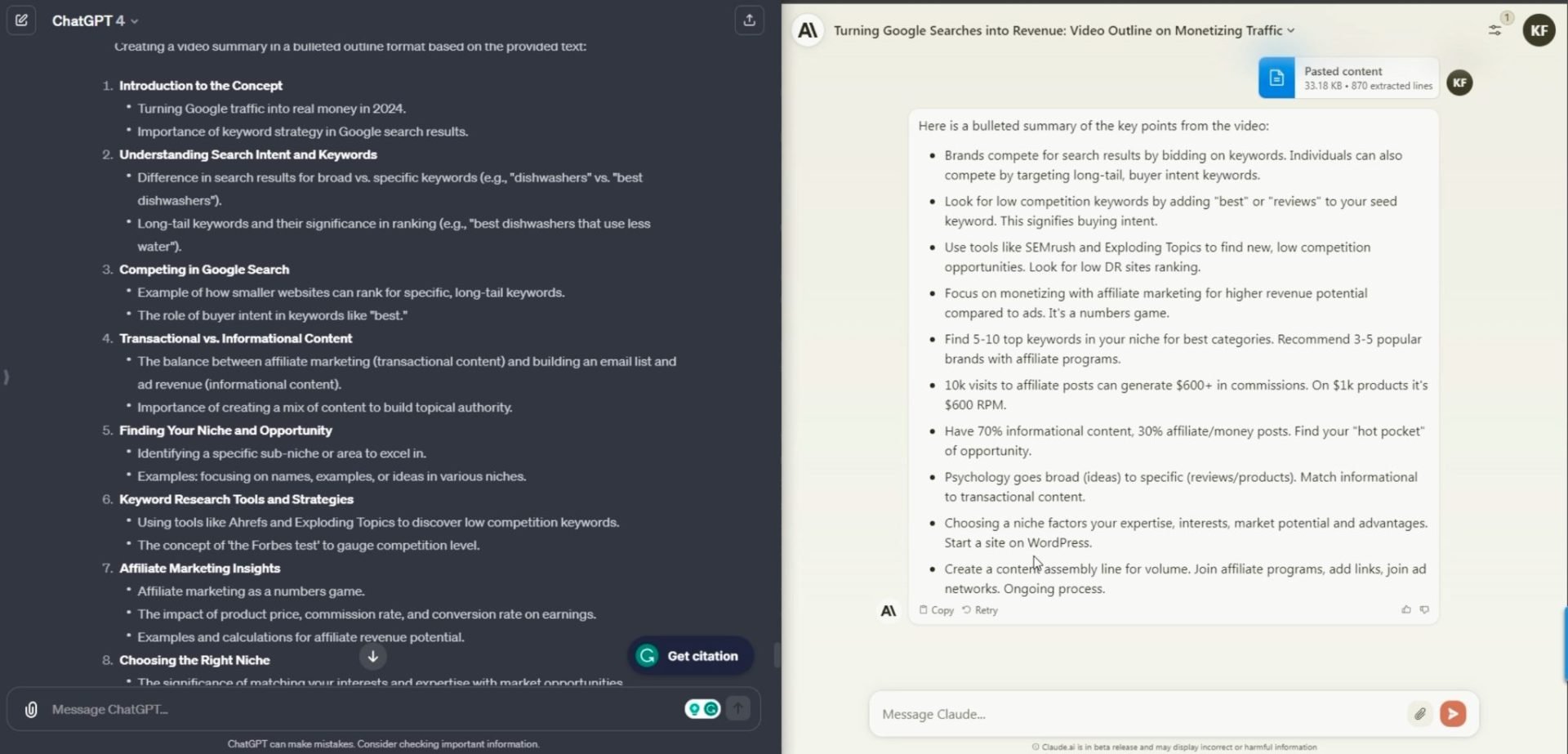
Above: ChatGPT vs. ClaudeAI summaries
Claude AI also features an easy-to-use interface that keeps simplicity and ease of use in mind.
Claude AI Pros:
- Quick comprehension: Generally, Claude AI understands precisely what’s required from the first prompt. There’s no need to “ask” twice for the desired results.
- Efficient text processing: The interface can handle a large input (i.e. a whole video transcript) without any issues.
- Concise summary: The summary is succinct and doesn’t include unnecessary information.
Claude AI Cons:
- Not as deep as ChatGPT: ChatGPT does offer more depth regarding some points. However, depending on the user’s needs, this can be a good/bad thing. It’s good as it provides more context; however, the more information a summary provides, the more time you have to spend to understand its content.
3. Jasper

Jasper offers a template called “Content Summarizer”. This blanket template is intended to output a summary of the text provided.
This sounds great on paper. The biggest problem is the input limit with this template – it offers a 16,000-character limit. For short YouTube videos, this isn’t an issue.
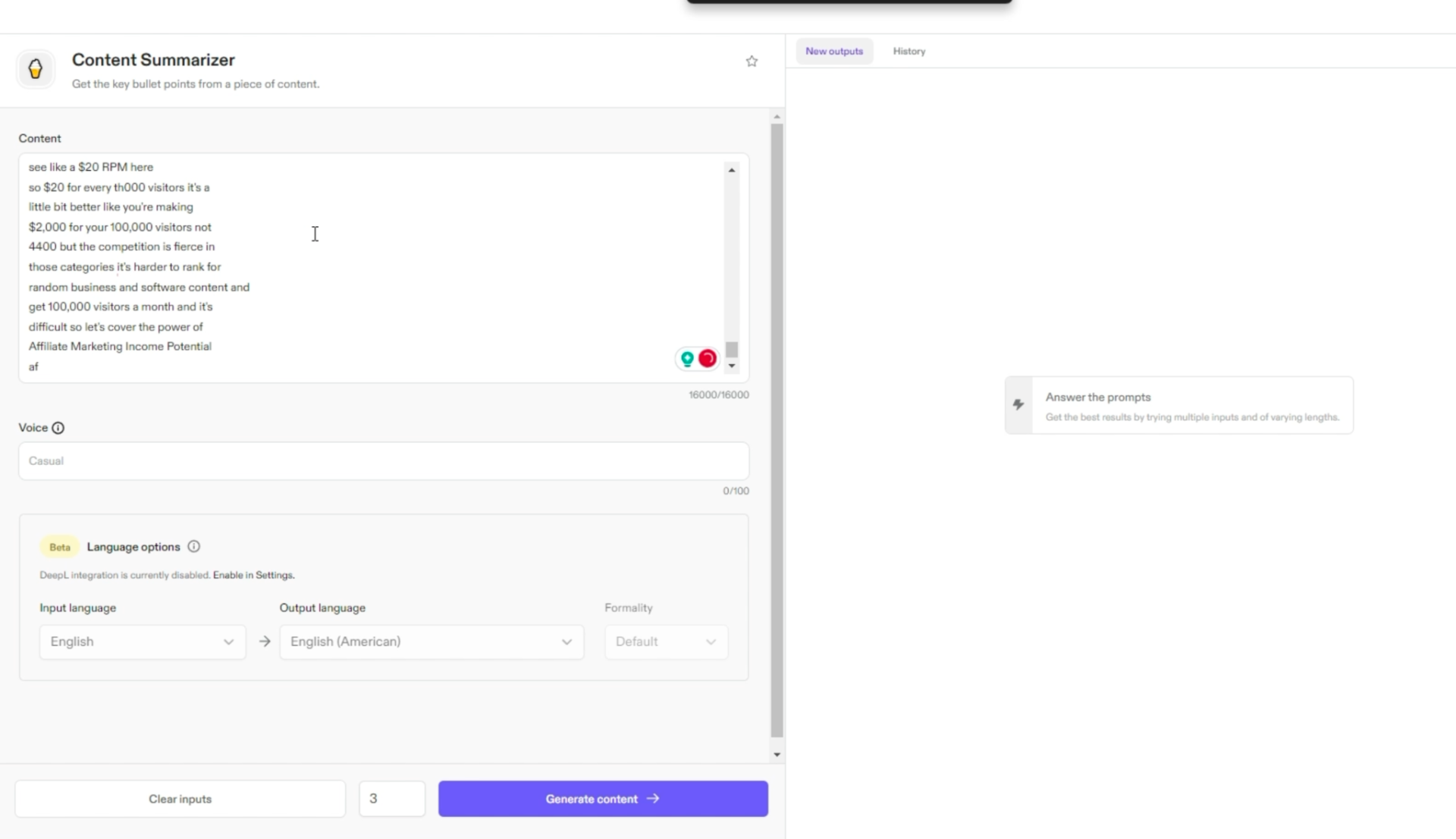
However, I had to break the transcript into three pieces for the video I wanted to summarize (about 25 minutes long).
This involved more time on my part.
I then had to take the three summaries and further summarize them. This produced a somewhat similar output to the previous tools. However, this summary was somewhat lacking compared to that of other tools.
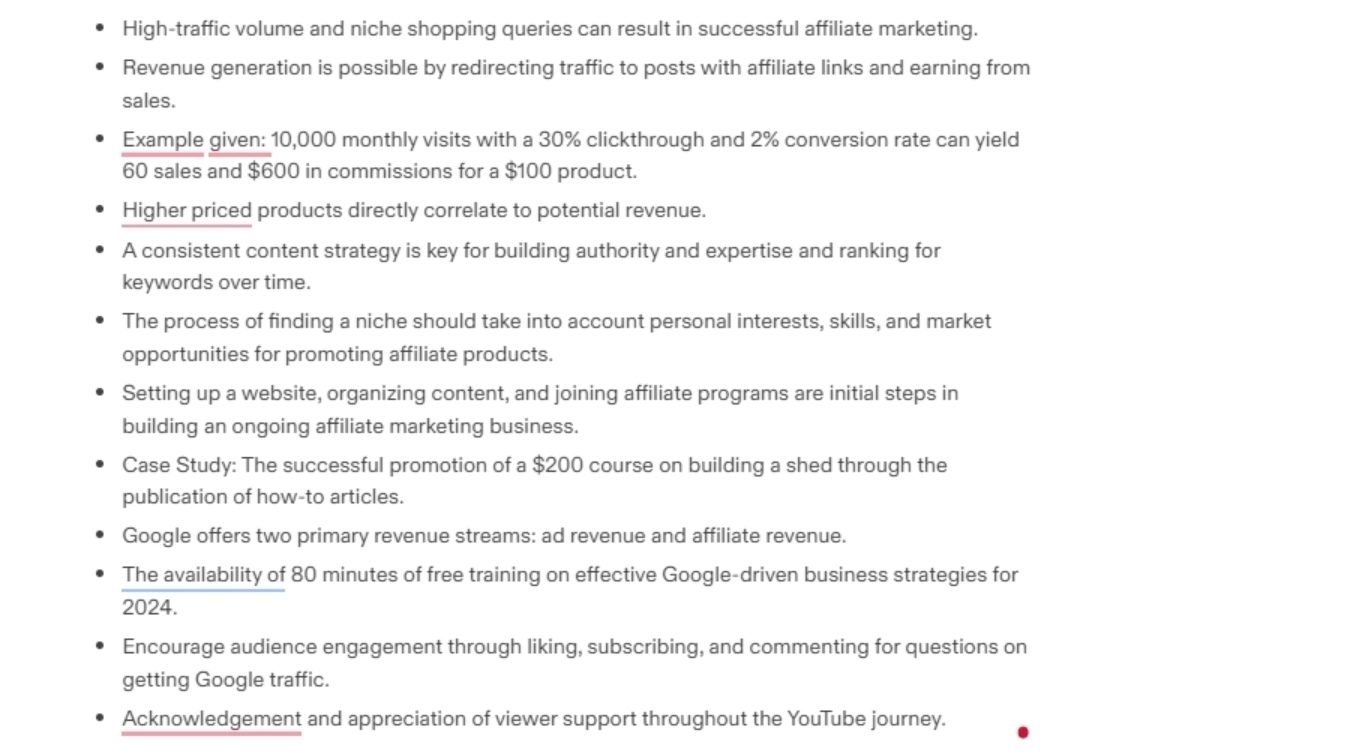
Jasper Pros:
- Multiple outputs: You can generate multiple outputs at one go. You can then pick and choose which summary works best.
- Summarization template: You don’t have to provide any prompts. When you provide your transcript (or any other text), the template “knows” what it needs to do.
Jasper Cons:
- Character limit: Jasper’s template has a 16,000-character limit. This limit requires multiple passes for longer YouTube transcripts.
- Lack of custom instructions: You don’t have a space to provide custom instructions to Jasper. You must take additional steps to get the desired summary if the first output isn’t what’s required.

4. Otter.ai
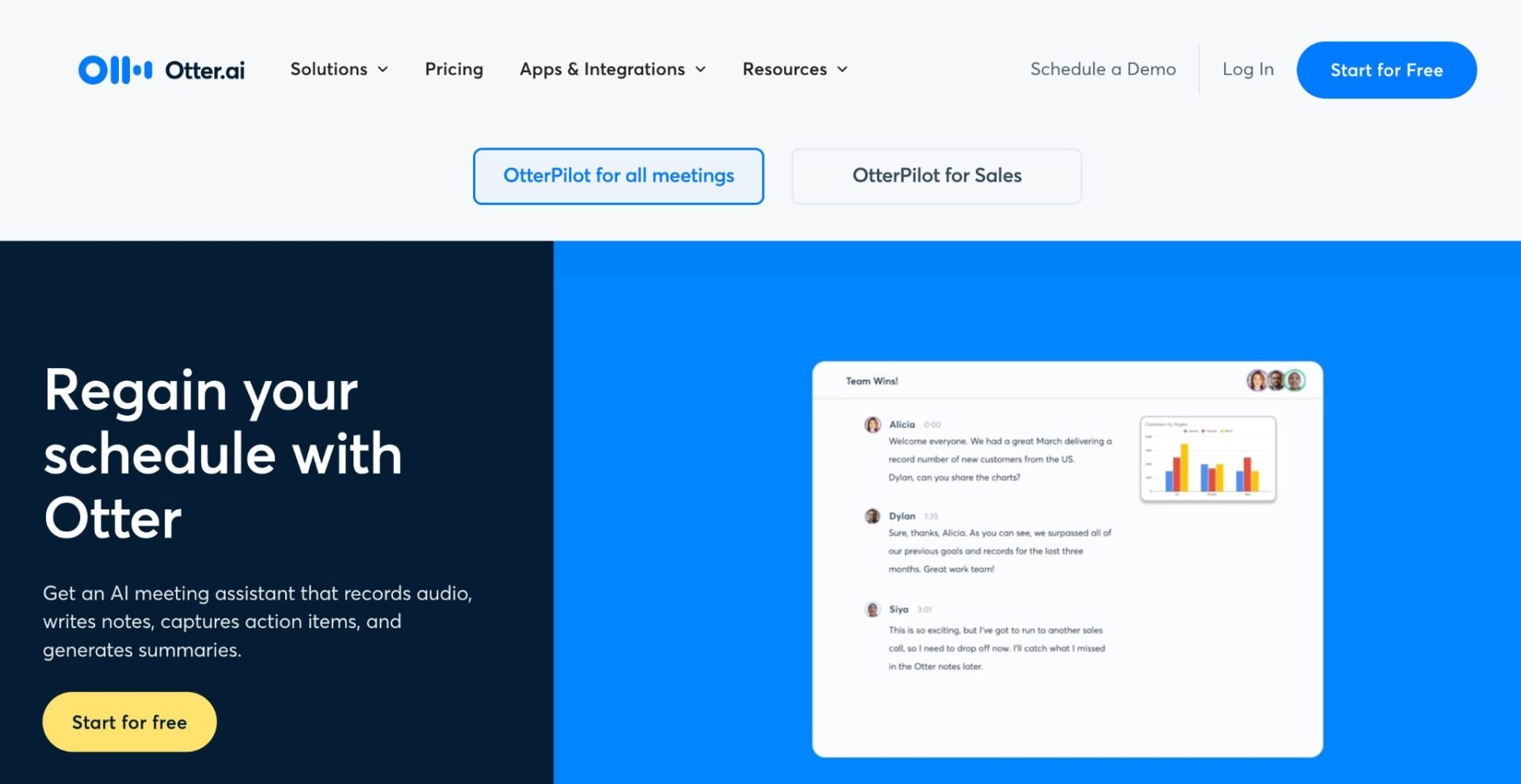
Otter isn’t purely a YouTube summarization tool. Many people use it to record interviews, conversations, and anything that involves speech-to-text.
You can also import audio files and get the transcription from these files.
When dealing with YouTube videos, you’ll have to:
- download the MP4/MP3 version of the video
- import it into Otter
- have the tool generate the transcript and
- then wait for the summary to happen.

There’s a lot of moving parts to the whole process.
However, I think there’s a role for Otter to play when generating YouTube summaries. If you’re working on multiple videos that require detailed notes and transcriptions, Otter could be a valuable tool.
It also has team collaboration features for larger projects.
In terms of the summary, you get (collapsable) points you can choose to expand. This feature makes it easy to focus on parts of the summary that you need at any specific moment.
Otter.ai Pros:
- Versatility: The tool can handle multiple input formats – you can dictate your speech or import different file formats.
- Expandable summaries: You can look at the whole summary or focus on specific parts.
- Slack integration: For businesses using Slack, you can send transcripts directly to your Slack channels, saving you time and effort with team collaboration.

Otter.ai Cons:
- Extra steps involved: You have to import a YouTube video (you can’t paste in a transcript). This means you’ll have to download the file from YouTube before you can process it.
What Makes a Good AI YouTube Video Summarizer?
There are a lot of tools that can create YouTube AI summaries and choosing the right tool depends on your specific needs.
There are also a few key factors to consider when choosing one tool over others. Here are the main factors.
The Tool Considers Context
A tool that understands what you’re looking to get from a summary and bases the output on a specific context is worth its weight in gold.
You don’t want a tool that provides the same output if you want to provide different contexts.
Let’s take this video as an example:
I might want to get a summary of this video in the context of someone who has 3+ years of experience running a blog.
On a different occasion, I might want to focus on what beginners can do to hit such goals.
Same video, two different contexts.
In both cases, the summary should contain similar points. However, the nuanced focus on beginners should give me a slightly different summary than the one addressed at the more experienced person.
Let’s see what ChatGPT comes up with. First, I’ll ask the tool to summarize this video for someone new to affiliate marketing. I pasted this prompt and the video transcript:

Here’s a part of the result:

Let’s now ask for a summary for someone who has 3+ years of experience in affiliate marketing. Here’s the new prompt:
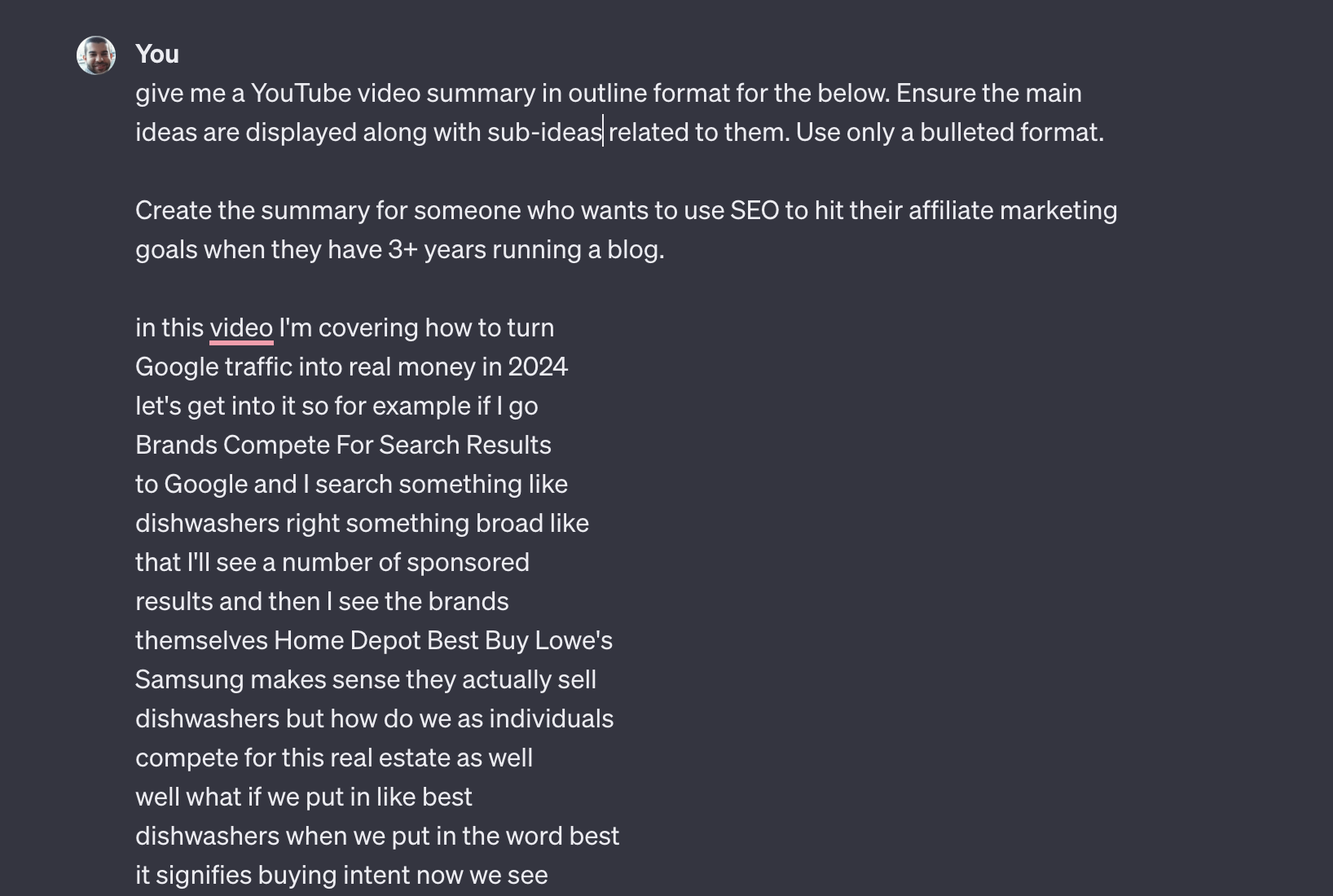
Here’s the result:

The first one goes into much more detail than the second one. This makes sense considering the first person needs more context (given their beginner knowledge) than the second.
Ability To Add Prompts
AI summarization tools might have their own “summary templates” or even a specific “YouTube summary template”. This isn’t necessarily bad, as it will make creating summaries faster.
However, having some level of control (through prompts or otherwise) is important.
For example:
- If you want to add context (like I mentioned above), you could add specific prompts.
- If you want to regenerate a summary with minor modifications, prompts can also help.
Removes Unnecessary Information
The last thing you want in a summary is for it to be as long as the transcript.
The aim is to distill information into usable chunks – without going through the video/text again.
Having a tool that understands what’s unnecessary (and removing it) is important.
Fast Processing Time
Speed is vital when creating summaries. The main idea is that you’re saving time while getting the essence of the YouTube video.
Ideally, you should look for a summarization tool that completes the job within a few seconds.
Unlimited Generations
If you’re creating lots of summaries, you don’t want to run out of credits (or have to wait several hours) when it comes to your next summary.
Since many tools work on a credit system, clarifying how a tool works (and knowing how many credits you have) is important.
Ideally, you’ll want a tool that offers unlimited summary generations. As a result, you won’t need to worry about waiting when getting work done.
What To Do After You Summarize A Video
You now have a YouTube video summary that’s ready to go. What do you do with it to get the most value?
Here are some ideas.
Review and Edit the Summary
Reviewing the summary generated by an AI tool is essential. You might want to remove further information to make the summary better.
I also suggest checking the output’s validity to ensure there aren’t missing points.
Moreover, if you want to retain information, it is best to understand how to act on it. Many AI tools can provide action steps helping you come up with what to do next.
Here’s an example from the video I’ve used in this article. In this case, I’m asking ChatGPT to give me the top 5 actions steps based on the summary to allow me to “turn
Google traffic into real money” (based on the video’s topic):

Here is the result:

This output helps make the summary actionable.
Consider Content Utilization
Consider the question:
How can I reuse the generated summary information in various situations?
Consider use cases like:
- study notes
- content creation
- briefings
Recycling content summaries and using them in multiple situations means you’ve done the work once and get results from them multiple times.
For example, if you’re building study notes, you could use a flashcards website to help you study.
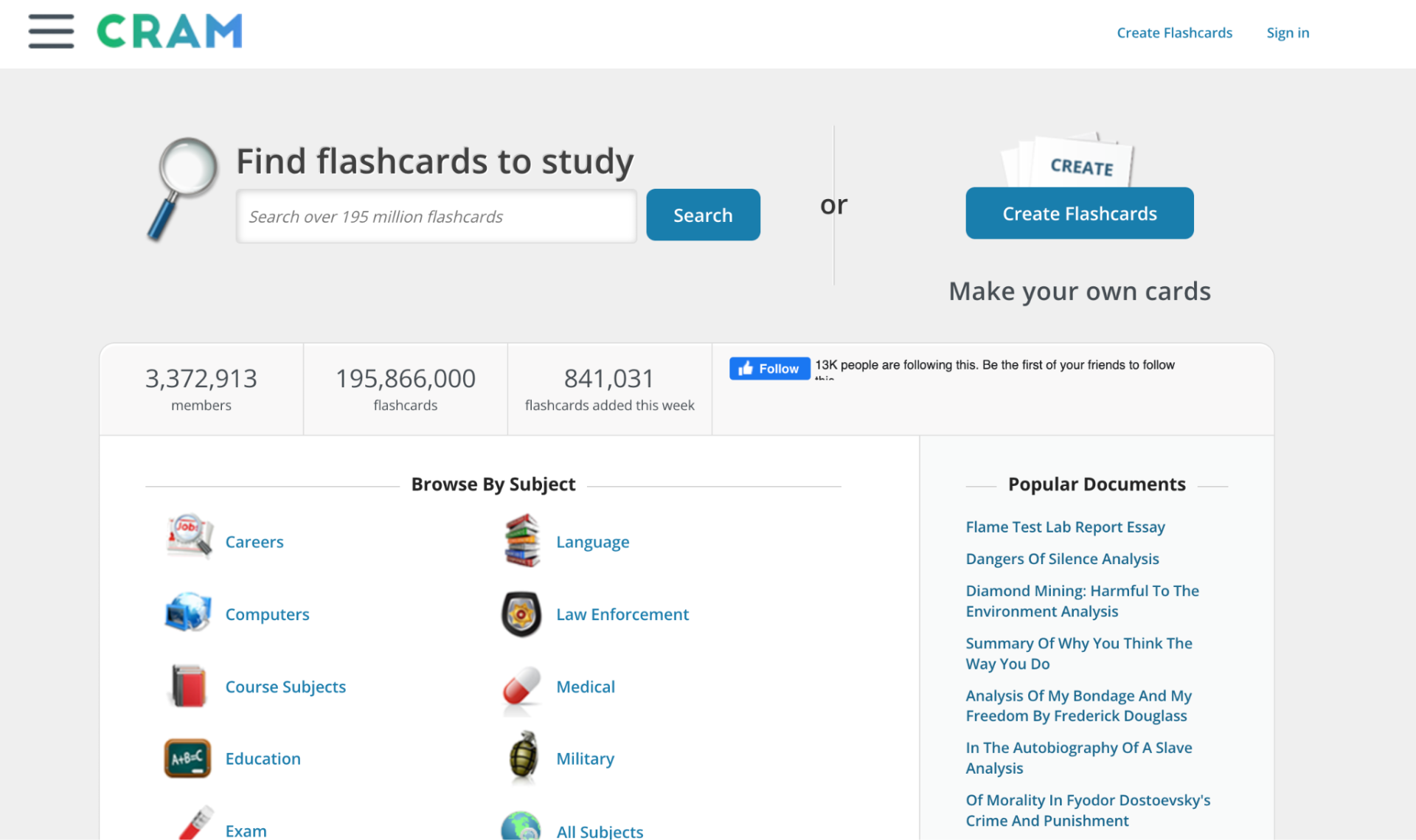
Source: cram.com
If you’re creating content, you can use the same base summary to outline different content formats for various social media platforms.
It all depends on your specific needs.
Think Of Collaborative Opportunities
Understanding a topic well and teaching it to others is one of the best ways to ensure you understand it.
Consider starting group discussions with others interested in your topics.
This “group dynamic” is one of the reasons why our Blog Growth Engine and YouTube Growth Engine communities are such a hit among our students.
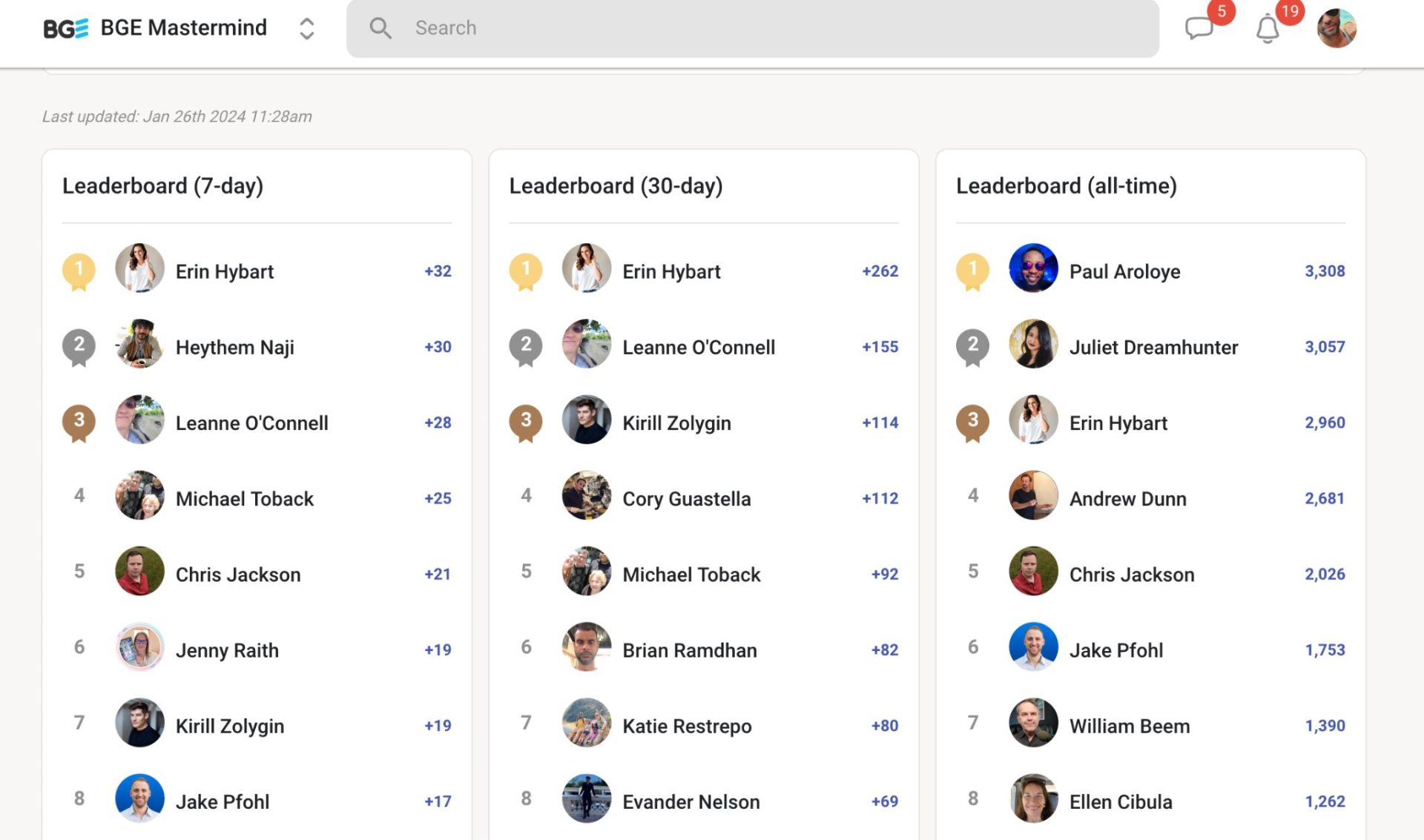
Conclusion
Summarizing YouTube videos using AI is a great way to get the most out of video content without wasting time.
When you’re looking for your next video summary, try out one of the tools mentioned above and let me know your favorite.
And remember: the more you use AI tools to assist you while directing the action, the better the output will be. I believe it’s all about using AI tools along with the human brain to produce the best possible outcome.





